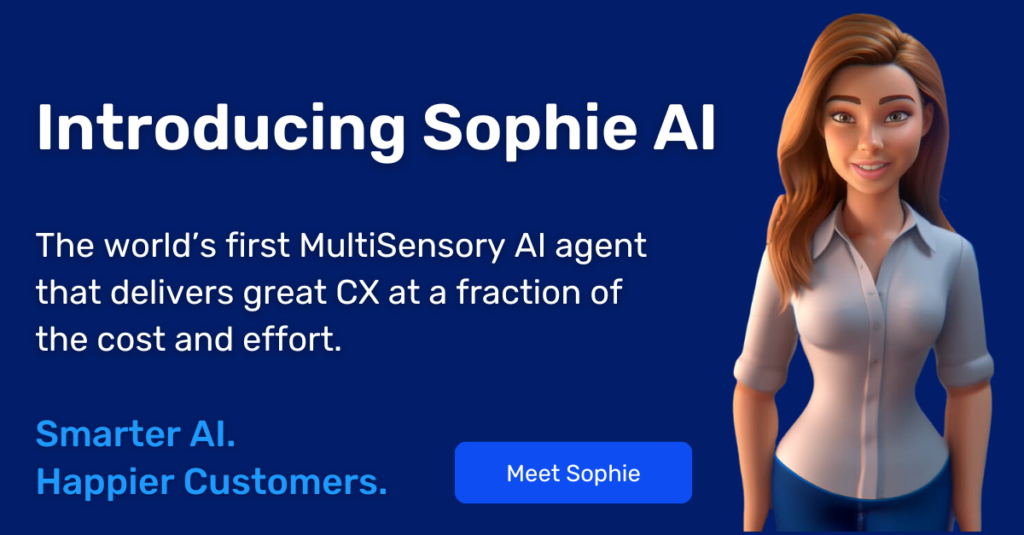As customer expectations continue to evolve, businesses are increasingly turning to Artificial Intelligence (AI) to enhance Customer Experience (CX). Leading AI-driven solutions, especially those empowered with visual AI, can analyze and summarize customer interactions, predict behaviors, streamline resolutions, and personalize experiences at scale. However, as with any technology, the integration of AI into customer support processes raises important questions about safeguarding CX.
Why Use AI for CX?
AI in customer experience management is transformative. By leveraging AI, companies can achieve:
- Enhanced Efficiency: AI automates routine tasks, allowing agents to focus on complex issues, thus speeding up response times and improving efficiency.
- Personalized Interactions: AI analyzes vast amounts of data to deliver tailored experiences, making customers feel understood and valued.
- Enables Scale: AI’s automation and personnel augmentation enables unprecedented growth and scale. AI can automate or augment new customer onboarding, setup and service, enabling unprecedented revenue growth.
- Proactive Service: AI’s predictive capabilities enable companies to anticipate customer needs and address issues before they escalate.
- Cost Reduction: Automating routine inquiries and tasks reduces the workload on human agents, which can significantly lower operational costs.
The benefits are clear, but what about the risks?
What Are the Risks?
Integrating AI while safeguarding CX isn’t without its challenges and risks:
- Accuracy of Guidance: AI systems, particularly Generative AI solutions, struggle to deliver accurate user guidance, especially when dealing with complex or multi-step tasks like troubleshooting an issue. These inaccuracies may be the result of LLM hallucination, inaccurate or inconsistent training data, or the logical limitations of LLMs.
- Data Privacy Concerns: AI systems depend on extensive data, increasing the risk of breaches and unintended biases. This reliance necessitates stringent data protection measures to safeguard customer information.
- Propagation of Biases: If not meticulously managed, AI can perpetuate existing societal biases found in its training data, leading to potentially unfair customer treatment. This issue affects individuals and can also impact a company’s reputation and compliance with legal standards.
- Loss of Human Touch: While AI excels in efficiency, it lacks the empathy of human agents. This gap can frustrate customers, especially in sensitive or complex situations that require a human touch.
Acknowledging these risks is the first step toward mitigating them.
How Can You Mitigate These Risks to Safeguard CX?
Mitigating the risks associated with AI and safeguarding CX involves strategic planning, robust technological safeguards, and continuous monitoring. Here’s how businesses can effectively address these challenges:
Train the AI on Accurate Consistent Documentation
Training your AI with accurate and consistent documentation is essential. Blend formal documentation and real-world service experience (tribal knowledge) to enrich your AI’s training set, ensuring it handles both typical and complex customer interactions effectively. For tasks like setup or troubleshooting, choose an LLM management provider with proven expertise in these areas.
Using a visual AI tool can further ease this process as it can recognize from an image or video which model the customer is using, any errors or issues, and guide users through the correct steps to setup or resolve an issue. Without this visual verification, the LLM could easily give a customer mistaken advice that can lead to frustration or even cause a malfunction in their product. The right tools and a focused approach on accuracy greatly enhances AI reliability and customer trust.
Validate Your AI Internally Through the Contact Center
Before deploying AI solutions broadly, it’s critical to validate their performance. Often, the best place to test and refine AI internally is within your contact center. This controlled setting allows you to observe how AI handles various customer interactions, and even simulate how effective your AI would be in automating these interactions. This ensures that the AI’s guidance is aligned with your customer’s needs, and your company’s standards and expectations – as well as the right tone that feels more human and less robotic. This human review helps to refine or fine-tune the AI, ensuring customer guidance is both safe and effective. This validation process not only helps in tweaking AI behaviors but also in detecting any deviations or unwanted behaviors before they affect the broader customer base.
Adding LLM Management Software as a Safeguard
Adding an LLM management software provides a crucial safety layer above your Language Learning Models (LLMs). This technology acts as a regulatory checkpoint, analyzing AI responses before they reach the customer to ensure they are appropriate, accurate, and free of unintended biases or misinformation. By setting up alerts for unusual AI behaviors or outlier responses, LLM management software can prompt human intervention when needed, thus maintaining a high standard of reliability and trust in AI communications.
Limit Your AI Scope to It’s Areas of Expertise
Defining the operational scope of your AI is essential to maintaining control over its applications. By limiting AI’s role to fields where your company holds expertise and where the AI has proven accurate and effective, you can ensure the AI makes decisions based on well-understood and accurate data. Furthermore, setting clear boundaries prevents AI from making extrapolations or decisions in areas where it may not have sufficient training or proven experience, thus reducing the risk of errors or inappropriate actions.
For instance, if your expertise is in customer service for electronics, and yourAI is proven effective at handling a particular type of hardware, your AI should not be making recommendations or decisions about unrelated products or services, or interacting with customers regarding hardware that is not yet proven effective. This is where a visual AI tool can be incredibly effective. Visual AI can verify (through images or video) that the customer is using the exact model product they claim to have, ensuring it is within the expertise of the AI. Furthermore, Visual AI can often identify the particular issue and status of the hardware or device far more effectively than users who lack deep product expertise.
A focused initial approach can lead to more sustainable success when deploying AI in customer service. Limit AI use initially to areas where it has proven effective. This may be something as basic as addressing common inquiries, or summarizing support interactions for agents. However, the greater value and scale will come from true automation that can resolve customer issues as good as, if not better than Tier 1 agents.
Regular Training and Updates
While incredibly self-sufficient, the best way to work with AI models is not to see them solely as set-and-forget tools. Ongoing training and updates, which some platforms can automate for you, help them stay relevant and effective. Regularly updating your AI with new data, the latest documentation, your latest tribal knowledge, and customer feedback ensures that the AI evolves with your business and customer needs. This ongoing training and refinement must also include reinforcement of ethical guidelines and privacy standards to keep the AI aligned with regulatory and company policies as this space continues to mature.
Collaborative AI Development
Involving multiple stakeholders, including tech teams, customer service managers, and compliance officers in AI development and oversight can provide a more comprehensive approach to risk mitigation. Collaboration ensures that the AI’s design and functionality consider diverse perspectives and requirements, which can help anticipate potential risks and design more robust AI solutions. This collaboration can also help decide when a customer should be moved from an AI agent to a live human to maintain the customer experience. Visual AI and multisensory Ai platforms such as Sophie AI can actually transition the customer and create the “warm handoff” between AI agents and human agents, preventing customer frustrations.
Conclusion
The use of AI in customer experience offers tremendous benefits, but it also necessitates careful consideration and mitigation of potential risks for safeguarding CX. Companies can effectively mitigate these risks by deploying multiple safeguards, including internal validations, technological safeguards, clearly defined scopes, regular updates, and collaborative development.
To learn how Sophie AI’s multisensory AI delivers remarkable, human-like experiences without compromising quality or safety, schedule your complimentary consultation today.







